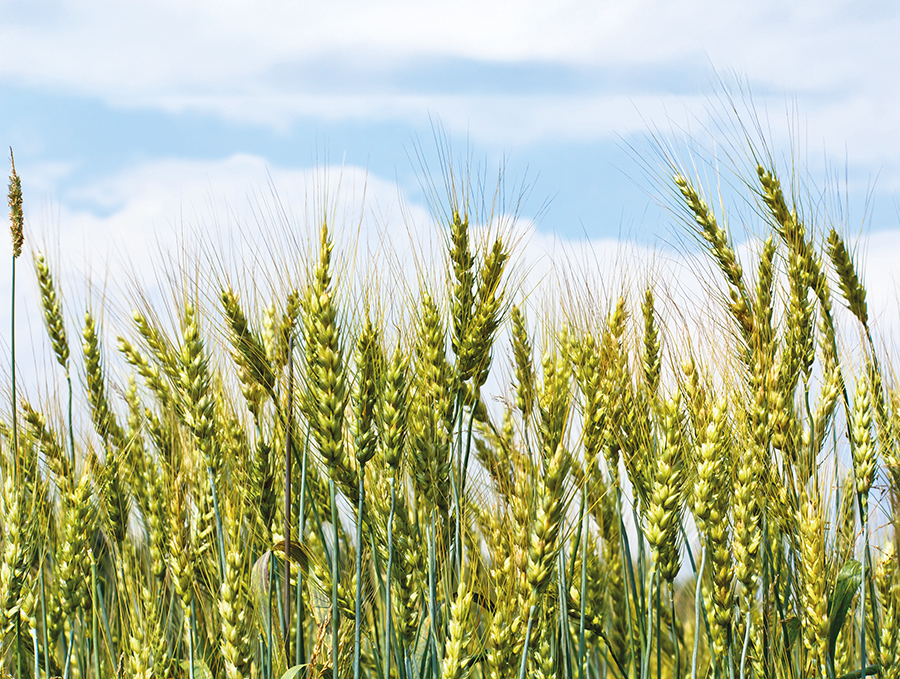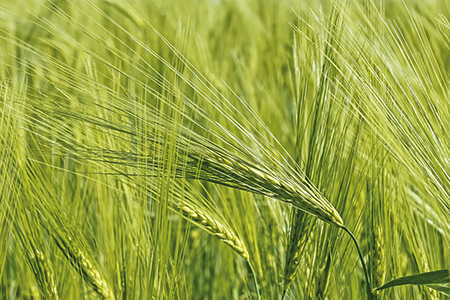Good choice of spring crop options for 2025
13th November 2024
Growers pondering crop choices for spring 2025 have much to consider – not least how best to ensure a balanced rotation, which crops have attractive market buy-backs and whether a short-term cover crop might be worth considering.

As ever, seed availability, forward prices and the condition of the land are likely to be the biggest factors in determining what is sown.
In what may seem like a repeat of this year, spring barley is likely to be among the preferred crop choices although the area is likely to be down on 2024, according to Tom Eaton, grain trading manager at Viterra.
“We anticipate a greater winter wheat crop area this autumn despite forward prices being rangebound with little to suggest an upward shift,” Mr Eaton says.
A bigger winter wheat area is likely to come at the expense of a smaller winter barley crop and a contraction in the area available for spring sowing.
“Spring barley premiums are likely to recover from current levels, but not to the extent seen in 2022/23. A vintage crop across the UK and Scandinavia in 2024 is still weighing on markets.
“Laureate is expected to remain the dominant variety in part because of its dual-purpose versatility, but there is increasing interest in Skyway which continues to do well with distillers and brewers,” he adds.
After the wet autumn and winter of 2023/24 in which the area of wheat in England fell 11% to 1.4 million hectares and winter barley decreased by 17% to 325,000 hectares, the spring barley area increased by 28% to 524,000 hectares. Oats were another crop that enjoyed a resurgence, with the area sown in England increasing 11% to 148,000 hectares in 2024, according to figures from Defra.
Oilseed rape saw another fall in the sown area in 2023/24, though this is perhaps due more to a fall in output prices and the threat posed by chewing pests rather than difficulties caused by the wet weather. Winter-sown oilseed rape accounts for 98% of the crop area in England and at 244,000 hectares, this was a 28% reduction compared with 2023 and the smallest crop area this millennium.
For spring 2025, the situation is likely to be much the same as this year, but there are rewarding opportunities for those who act early to secure them, says Rodger Shirreff, Agrii national seed business manager.
“At the macro level the situation is broadly similar to spring 2024. There is good availability but not for all crops and varieties, which means there are good premiums available for some crops due to tighter supply,” he says.
Spring barley
For spring barley, the market for which is closely tracking that of the wider cereals market, interest is dominated by two varieties: Laureate and Skyway.
“Laureate seed is not unlimited; Skyway continues to gain acceptance with end-users and consequently benefits from across-industry buy-backs. Both varieties are expected to be the first to sell out,” Mr Shirreff says.
Two spring barley varieties worth a close look are Diviner, a provisionally recommended variety expected to gain full recommendation on the 2025 AHDB Recommended List, and Belter, which is a year behind in its progression but is performing well in small-scale testing.
“Both Diviner and Belter are rapidly gaining traction among UK maltsters. Diviner has good agronomics with average speed of ripening, low skinning levels and good standing power. Diviner is an out-and-out distiller, and its malting quality gives it broad appeal.
“Belter is a gem of a variety, but a year away from joining the RL. It is likely to gain approval in Europe so will have good export potential. It is stiff strawed and is earlier to mature than Laureate with higher specific weight and better grain quality. Belter is well-placed to become the market’s preferred dual-purpose variety in the next few years,” he says.
For feed growers whose focus is maximum yield a more suitable variety would be Hurler. Its stiff straw means it can be pushed hard and is an ideal choice for heavier land.
“Hurler is the highest yielding spring barley variety available. Its stiff straw means there is little risk of it lodging and makes it suited to heavy land or bad black-grass situations where there is no intention of seeking a malting premium,” Mr Shirreff says.
Spring oats
The appeal of oats is bolstered by its potential as a cereal break-crop and its exceptional growth habit which marks it out, especially spring oats, as being ultra-competitive against black-grass. Unfortunately, this is undermined by the lack of viable markets. This is not to say there aren’t rewarding contracts available, says Rebecca White, Agrii specialist break-crop product manager.
“Husked oats tend to benefit from steady demand but suffer from fluctuating supply, which, if you don’t have a buy back contract, is a shame, as they have much to offer. WPB Isabel has edged Canyon in recent years to become a grower favourite. Merlin has agronomics and grain quality attributes almost identical to Canyon and is the highest yielding variety on the RL. While Canyon is established among millers, Merlin is gaining traction with Richardson Milling giving it a thumbs-up last year,” Mrs White says.
Perhaps the most attractive spring oat option is naked oats, with GB Seeds offering non-defaultable contracts guaranteeing to buy-back 100% of farm production. There is no geographical limit with markets across Great Britain.

“The market for naked oats is no longer over-supplied; in fact, there is a marked deficit. As a result, the contracts favour the grower because they simply guarantee to buy-back the whole crop, rather than a specified volume.
“There is the option to fix the base price at the grower’s discretion while premiums rise with the duration of storage up to a maximum of £45/t. Yields are typically 4–6t/ha, but low variable costs mean a gross margin of £1,000–1,100/ha is easily achievable,” she says.
Agrii is offering the established varieties Oliver and Lennon and has limited availability of a new variety, Iceni.
“Oliver is marginally higher yielding with better grain quality than Lennon and has been in the market since 2022 while Lennon is shorter and has slightly better resistance to mildew and crown rust,” Mrs White says.
“Iceni looks promising. In trials in 2024 it produced larger grains than other varieties which is a characteristic that end-users appreciate and its disease resistance, especially to crown rust, also looks better than other varieties. We are seeking commercial crops in 2025 to further evaluate its market suitability,” she adds.
Naked oat agronomics
The appeal of naked oats has been undermined by poor agronomy but where this is done properly, especially for nutrients, both spring and winter crops can deliver rewarding results, says John Miles, Agrii seed technical manager.
“The crop can tolerate a wide range of soils, so is well-suited to farms across Great Britain, but it is best to avoid sites that suffer from grassweeds, are very light or are exposed as oats are more susceptible to winter kill than other cereals,” he says.
Oats are highly tolerant to acidity and can be grown on soils as low as pH 5.3 but are prone to manganese and copper deficiency.
“Oats are especially susceptible to manganese deficiency with yield losses of 30–60% if not corrected. As with all cereals, a manganese seed treatment such as i-Man should be applied as routine. In Agrii trials, i-Man has consistently delivered the greatest return on spend of any seed treatment, so represents excellent value for money. Copper deficiency can be symptomless at the early stages before materialising as yellow tipping or spiralising of leaves. A copper treatment, such as Fielder Copper, should be applied where soils are known to be deficient,” Mr Miles says.
Disease control in oats is easier than in other cereals with powdery mildew and crown rust having the greatest potential for damage.
Broad-leaved weed control is reasonably straight-forward, but grassweed control is often challenging with nothing available to control wild oats and limited options for annual meadow grass. Perhaps the greatest cause for confusion – and consequential poor performance – is around seed rates.
“Naked oats don’t have a vernalisation requirement, so can be drilled from September through to the end of March. Where opinions differ, however, is on seed rates; there is good evidence to suggest they can be far lower than current practice suggests,” Mr Miles says.
Standard practice is based on a target spring plant population of 250 plants/m2, broadly equivalent to 350–400 seeds/m2 depending on germination percentage and thousand grain weight.
A target population of 250 plants/m2 is considered desirable because it accounts for poor germination while being enough to give a crop in a difficult season and not too high to cause extreme lodging in a kind year. Earlier sowing will also enable more tillering, so should be considered.
“There will be seasons where lower seed rates are worthwhile, just not every season and you won’t know if you could have got away with it until afterwards. What is undeniable though is the impact lodging on performance. With the exception of semi-dwarf varieties, a PGR should be applied as a matter of routine to both husked and naked varieties,” he adds.
Pulses
Pulse crops offer a range of workload and rotational benefits and with good premiums available for peas, they are likely to deliver better returns than beans.
“GB Seeds has non-defaultable buy-back contracts for blue, yellow and maple peas. These offer a fixed price for blue peas (up to 10% bleaching) and for yellow (no colour spec) for the produce of the crop area,” Mrs White says.
“There are many markets both home and export for human and animal consumption and the contracts are flexible with only standard specification around admixture and moisture,” she adds.
Seed treatments
The benefits of bridging the ‘hunger gap’ – the period between when the seedling has exhausted the nutrient reserves of the seed but has not yet developed the root system to properly access reserves in the soil – has led to the proliferation of products claiming nutrient and bio-stimulant benefits. Only a few have been shown to be worthwhile, warns David Leaper, Agrii technical manager.
“The market is awash with products and claims. In our trials, only a few have come close to delivering what they claim, so it is perhaps not surprising that many growers and agronomists are sceptical of these products.”
Early proponents of nutritional seed treatments advised their use where soil or grain analysis indicated a deficiency, but opinions have changed as trials have consistently demonstrated a performance gain regardless of soil availability.
“The manganese seed treatment i-Man and zinc treatment Zax routinely deliver greater yield uplifts than Vibrance Duo, but these are not mutually exclusive. Instead, we see a case for co-applying both i-Man and Vibrance Duo,” he adds.
For peas and beans, Prepper, a fungicidal seed treatment containing fludioxonil, gives a reduction in both Fusarium and Ascochyta leaf and pod spot.
“Damping off, also known as foot rot, caused by Fusarium solani and Didymella pinodella are especially common on land with a history of peas and can cause serious yield losses. These are typically 10–30% but can be as high as 60% in field peas and 85% in beans, so a seed treatment is often highly worthwhile,” he adds.
Read more arable news



